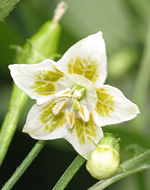Chilli Species
Capsicum is a genus of flowering plants in the nightshade family Solanaceae.
Quick Guide To The Genus Capsicum
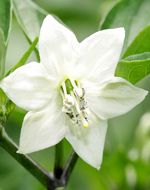 Capsicum Annuum
Capsicum Annuum
Capsicum annuum (annuum meaning annual, although under correct growing conditions they are perennials) is the most extensively cultivated throughout the world of the five species, and because it cross pollinates so easily there are probably thousands of varieties existing. Annuums are really divided into two categories: sweet (or mild) and hot. Too many leaf variations to describe, but smooth rarely hairy, the single flowers are an off-white (sometimes purplish) colour, no spots, while the stem is densely branched and up to 100 centimetres (36 in) tall.
Types include: Ancho, Anaheim, Big Bertha, Bolivian Rainbow, Cayenne, Cherry Bomb, Cayenne, Cubanelle, Chimayó, Chiltepin, Fresno, Fiesta, Firecracker, Goat Horn, Hungarian Yellow Wax, Jalapeño, Jaloro, Nu Mex Mulato, Mirasol, Peter Pepper, Peruvian Purple, Pasilla, Piemento, Poblano, Super Chili, Santa Fe Grande, Sweet Banana, Thai Hot.
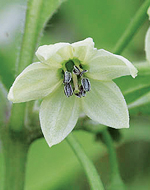 Capsicum Chinense
Capsicum Chinense
Capsicum chinense (chinense, meaning "from China," which is also an incorrect designation, as this species include the habanero's). Originating from the Amazon into the Caribbean and then spreading into Central and South America. Growing up to 100 centimetres (36 in) tall, usually tree like with pale to medium green large and wrinkled leaves. Flowers have white to yellowish corollas, no spots with purple anthers and filaments. Slow growers with a long season.
Types include: Habanero, Congo Pepper, Goat pepper, Scotch Bonnet, Datil, Fatalii, Red Savina, Madame Jeanette, Naga Jolokia, 7Pot, Trinidad Scorpions, Moruga.
Capsicum Baccatum
Capsicum Baccatum (baccatum, meaning "berrylike), originated in Peru or Bolivia and are now found throughout South America. Growing up to 150 centimetres (54 in) tall, bush like with smooth relatively small leaves. This species is distinguished from the other species by the flower corollas being white with distinctive dark green or yello/brown spots, and anthers being yellow or tan. Fruity flavour being used in salsas or dried and ground into powders.
Types include: Ají, Brazilian Starfish, Lemon Drop, Piquanté (Brand name Pepperdew)
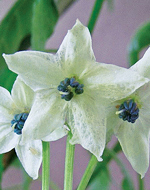 Capsicum Fruitescens
Capsicum Fruitescens
Capsicum fruitescens (fruitescens, meaning shrubby or bushy) coming from the Amazon basin in Brazil and the Mexican city of Tabasco, hence the most recognizable one being the Tabasco. Now finding their way to India and the Far East where they are called bird pepper. Tree like sturdy plant growing to 150 centimetres (54 in) tall, with smooth oval shiny leaves up to 2.5 inches. Flowers have greenish white corollas with no spots and blue anthers, erect pods up to 1.5 inches long. Makes good pot plants.
Types include: Tabasco African birdseye Malagueta Thai pepper Demon Red.
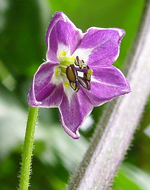 Capsicum Pubescens
Capsicum Pubescens
Capsicum pubescens (pubescens, meaning hairy), originates in Bolivia, now being cultivated from the Andes to Mexico and Central America. The common name for this species is rocoto. Bushy tall sprawling plant up to 200 centimetres (72 in) tall oval dark green leaves being up to 3 inches long and very hairy. Flowers have purple corollas, no spots, purple anthers and stand erect above the leaves. Hardy plants with a long growing season. Thee pods are fleshy with black seeds and are usually eaten fresh in salsas or stuffed but they are very hot.
Types include: Manzano, Amerillo, Manzanoi Rojo, Rocoto.
 Wild Capsicums
Wild Capsicums
Wild capsicum plants are the ancestors of our current domesticated peppers and only grow naturally in Americas, from Argentina to southwest USA. There are currently about 30 known and verified wild capsicum species. Wild capsicum species excel in beauty and are mainly shrub like, the flowers vary in colour and shape, many are white or cream with purple, green or brown spots, although there are purples and one species known with yellow flowers. Not only the flowers of wild capsicums are extraordinary, the leaves are special too with varying shapes and some growing with hairs grow on them.
Types include: Capsicum rhomboideum, Capsicum galapagoense, Capsicum tovari, Capsicum eximium, Capsicum flexuosum, Capsicum buforum.

